Synthesized Nanorods Hydroxyapatite by Microwave-Assisted Technology for In Vitro Osteoporotic Bone Regeneration through Wnt/β-Catenin Pathway
Abstract
:1. Introduction
2. Materials and Methods
2.1. Materials
2.2. Animal and Ethical Approval
2.3. Synthesis of Nanorods HA Samples
2.4. Sintering of HA Discs
2.5. Characterization of HA Samples
2.6. Isolation of Osteoblast Cells and Induction of Osteoclast Cell Formation
2.7. Induction of Osteoclast Cell Formation (Induction of Osteoporosis)
2.8. Culture of Osteoblast (OB) and Osteoclast (OC) on HA Discs
2.9. Cell Viability and Proliferation Test
2.10. Mineralization Detection
2.11. Bone Remodeling Biomarkers
2.12. Molecular Investigations
2.13. Statistical Analysis
3. Results and Discussion
3.1. Chemical Analysis of Hydroxyapatite Samples
3.1.1. X-ray Diffraction (XRD) Analysis
3.1.2. Fourier Transform Infrared Spectra of HA Powder
3.1.3. Thermal Stability Analysis of HA Powder
3.1.4. Microstructure of HA Powder Using Transmission Electron Microscope
3.1.5. Scanning Electronic Micrograph of HA Powder
3.1.6. The Elemental Compositions of HA Powder
3.1.7. The Mechanical Properties of HA Discs
3.2. Effect of HA on Osteoporotic Bone Regeneration
3.2.1. Effect of HA Treatment on Biological Characteristics of Osteoblast and Osteoclast Cells
3.2.2. Effect of Hydroxyapatite Treatment in Bone-MSC and Osteoblast Death Signals
4. Conclusions
Author Contributions
Funding
Institutional Review Board Statement
Informed Consent Statement
Data Availability Statement
Acknowledgments
Conflicts of Interest
References
- Gomes, D.S.; Santos, A.M.C.; Neves, G.A.; Menezes, R.R. A brief review on hydroxyapatite production and use in biomedicine. Ceramica 2019, 65, 282–302. [Google Scholar] [CrossRef] [Green Version]
- Kuśnieruk, S.; Wojnarowicz, J.; Chodara, A.; Chudoba, T.; Gierlotka, S.; Lojkowski, W. Influence of hydrothermal synthesis parameters on the properties of hydroxyapatite nanoparticles. Beilstein J. Nanotechnol. 2016, 7, 1586–1601. [Google Scholar] [CrossRef] [PubMed] [Green Version]
- Boskey, A.L. Bone composition: Relationship to bone fragility and antiosteoporotic drug effects. Bonekey Rep. 2013, 2, 447. [Google Scholar] [CrossRef] [Green Version]
- Gheita, T.A.; Hammam, N. Epidemiology and awareness of osteoporosis: A viewpoint from the Middle East and North Africa. Int. J. Clin. Rheumatol 2018, 13, 134–147. [Google Scholar]
- Liu, J.; Curtis, E.M.; Cooper, C.; Harvey, N.C. State of the art in osteoporosis risk assessment and treatment. J. Endocrinol. Investig. 2019, 42, 1149–1164. [Google Scholar] [CrossRef] [PubMed] [Green Version]
- Mowafy, M.A.; Kamel, L.M.; Hamed, S.T.; Mohamed, D.A.; Taha, Y.M. Osteoporosis risk prediction among a group of postmenopausal females: A case-control study. Egypt. Fam. Med. J. 2019, 3, 65–82. [Google Scholar] [CrossRef]
- Ukon, Y.; Makino, T.; Kodama, J.; Tsukazaki, H.; Tateiwa, D.; Yoshikawa, H.; Kaito, T. Molecular-based treatment strategies for osteoporosis: A literature review. Int. J. Mol. Sci. 2019, 20, 2557. [Google Scholar] [CrossRef] [PubMed] [Green Version]
- Chen, J.; Sambrook, P. Antiresorptive therapies for osteoporosis: A clinical overview. Nat. Rev. Endocrinol. 2011, 8, 81–91. [Google Scholar] [CrossRef] [PubMed]
- O’Brien, C.A.; Jia, D.; Plotkin, L.I.; Bellido, T.; Powers, C.C.; Stewart, S.A.; Manolagas, S.C.; Weinstein, R.S. Glucocorticoids act directly on osteoblasts and osteocytes to induce their apoptosis and reduce bone formation and strength. Endocrinology 2004, 145, 1835–1841. [Google Scholar] [CrossRef] [PubMed] [Green Version]
- Weinstein, R.S. Glucocorticoid-induced osteoporosis and osteonecrosis. Endocrinol. Metab. Clin. N. Am. 2012, 41, 595–611. [Google Scholar] [CrossRef] [Green Version]
- Hench, L.L. Bioceramics: From concept to clinic. J. Am. Ceram. Soc. 1991, 74, 1487–1510. [Google Scholar] [CrossRef]
- Kolos, E.C.; Ruys, A.J. Osteoblast attachment to hydroxyapatite micro-tube scaffolds. J. Mater. Sci. Mater. Med. 2014, 25, 1801–1817. [Google Scholar] [CrossRef] [PubMed]
- Ginebra, M.P.; Espanol, M.; Maazouz, Y.; Bergez, V.; Pastorino, D. Bioceramics and bone healing. EFORT Open Rev. 2018, 3, 173–183. [Google Scholar] [CrossRef] [PubMed]
- Wang, Y.; Pan, J.; Zhang, Y.; Li, X.; Zhang, Z.; Wang, P.; Qin, Z.; Li, J. Wnt and Notch signaling pathways in calcium phosphate-enhanced osteogenic differentiation: A pilot study. J. Biomed. Mater. Res. Part B Appl. Biomater. 2019, 107, 149–160. [Google Scholar] [CrossRef] [Green Version]
- Moorer, M.C.; Riddle, R.C. Regulation of osteoblast metabolism by Wnt signaling. Endocrinol. Metab. 2018, 33, 318–330. [Google Scholar] [CrossRef]
- Rial, R.; González-Durruthy, M.; Liu, Z.; Ruso, J.M. Advanced materials based on nanosized hydroxyapatite. Molecules 2021, 26, 3190. [Google Scholar] [CrossRef]
- Tas, A.C. Combustion synthesis of calcium phosphate bioceramic powders. J. Eur. Ceram. Soc. 2000, 20, 2389–2394. [Google Scholar] [CrossRef]
- Shah, R.K.; Fahmi, M.N.; Mat, A.H.; Zainal, A.A. The synthesis of hydroxyapatite through the precipitation method. Med. J. Malaysia 2004, 59, 75–76. [Google Scholar]
- Isa, N.N.C.; Mohd, Y.; Yury, N. Electrochemical deposition and characterization of hydroxyapatite (HAp) on titanium substrate. APCBEE Procedia 2012, 3, 46–52. [Google Scholar] [CrossRef] [Green Version]
- Fathi, M.; Hanifi, A. Evaluation and characterization of nanostructure hydroxyapatite powder prepared by simple Sol-Gel method. Mater. Lett. 2007, 61, 3978–3983. [Google Scholar] [CrossRef]
- Earl, J.S.; Wood, D.J.; Milne, S.J. Hydrothermal synthesis of hydroxyapatite. J. Phys. Conf. Ser. 2006, 26, 268–271. [Google Scholar] [CrossRef]
- Lak, A.; Mazloumi, M.; Mohajerani, M.S.; Zanganeh, S.; Shayegh, M.R.; Kajbafvala, A.; Arami, H.; Sadrnezhaad, S.K. Rapid formation of mono-dispersed hydroxyapatite nanorods with narrow-size distribution via microwave irradiation. J. Am. Ceram. Soc. 2008, 91, 3580–3584. [Google Scholar] [CrossRef]
- Eliaz, N.; Metoki, N. Calcium phosphate bioceramics: A review of their history, structure, properties, coating technologies and biomedical applications. Materials 2017, 10, 334. [Google Scholar] [CrossRef] [PubMed] [Green Version]
- Corrales, L.P.; Esteves, M.L.; Vick, J.E. Scaffold design for bone regeneration. Journal of nanoscience and nanotechnology. J. Nanosci. Nanotechnol. 2014, 14, 15–56. [Google Scholar] [CrossRef] [PubMed] [Green Version]
- Ramesh, S.; Aw, K.L.; Tolouei, R.; Amiriyan, M.; Tan, C.Y.; Hamdi, M.; Purbolaksono, J.; Hassan, M.A.; Teng, W.D. Sintering properties of hydroxyapatite powders prepared using different methods. Ceram. Int. 2013, 39, 111–119. [Google Scholar] [CrossRef]
- Abdelrazek, K. Advanced sintering of nano-ceramic materials. In Ceramic Materials: Progress in Modern Ceramics; IntechOpen: London, UK, 2012. [Google Scholar]
- Menezes, R.; Souto, P.; Kiminami, R.H. Microwave hybrid fast sintering of porcelain bodies. J. Mater. Process. Technol. 2007, 190, 223–229. [Google Scholar] [CrossRef]
- Gamit, D.N.; Chudasama, M.K. Size-effect in microwave processing of engineering materials—A review. J. Mech. Eng. Sci. 2020, 14, 6770–6788. [Google Scholar] [CrossRef]
- Ali, A.F.; Alrowaili, Z.A.; El-Giar, E.M.; Ahmed, M.M.; El-Kady, A.M. Novel green synthesis of hydroxyapatite uniform nanorods via microwave-hydrothermal route using licorice root extract as template. Ceram. Int. 2021, 47, 3928–3937. [Google Scholar] [CrossRef]
- Fang, Y.; Agrawal, D.K.; Roy, D.M.; Roy, R. Microwave sintering of hydroxyapatite ceramics. J. Mater. Res. 1994, 9, 180–187. [Google Scholar] [CrossRef] [Green Version]
- Faeghinia, A.; Ebadzadeh, T. Effect of microwave conditions on sintering of hydroxyapatite ceramics. Sci. Sinter. 2020, 52, 469–479. [Google Scholar] [CrossRef]
- Sahu, S.; Mehra, D.; Agarwal, R. Characterization and thermal analysis of hydroxyapatite bioceramic powder synthesized by Sol-Gel technique. IJAST J. 2012, 3, 281–289. [Google Scholar]
- Venkateswarlu, K.; Chandra Bose, A.; Rameshbabu, N. X-ray peak broadening studies of nanocrystalline hydroxyapatite by Williamson Hall analysis. Phys. B Condens. Matter 2010, 405, 4256–4261. [Google Scholar] [CrossRef]
- Sathiyavimal, S.; Vasantharaj, S.; LewisOscar, F.; Pugazhendhi, A.; Subashkumar, R. Biosynthesis and characterization of hydroxyapatite and its composite (hydroxyapatite-gelatin-chitosan-fibrin-bone ash) for bone tissue engineering applications. Int. J. Biol. Macromol. 2019, 129, 844–852. [Google Scholar] [CrossRef] [PubMed]
- Ungureanu, D.; Angelescu, N.; Ion, R.-M.; Elena Valentina, S.; Rizescu, C. Synthesis and characterization of hydroxyapatite nanopowders by chemical precipitation. In Recent Researches in Communications, Automation, Signal Processing, Nanotechnology, Astronomy and Nuclear Physics; WSEAS Press: London, UK, 2011. [Google Scholar]
- Deligianni, D.D.; Katsala, N.D.; Koutsoukos, P.G.; Missirlis, Y.F. Effect of surface roughness of hydroxyapatite on human bone marrow cell adhesion, proliferation, differentiation and detachment strength. Biomaterials 2000, 22, 87–96. [Google Scholar] [CrossRef]
- Singh, R.; Tan, C.Y.; Bhaduri, S.; Teng, W. Rapid densification of nanocrystalline hydroxyapatite for biomedical applications. Ceram. Int. 2007, 33, 1363–1367. [Google Scholar] [CrossRef]
- Stern, A.R.; Stern, M.M.; Van Dyke, M.E.; Jähn, K.; Prideaux, M.; Bonewald, L.F. Isolation and culture of primary osteocytes from the long bones of skeletally mature and aged mice. Biotechniques 2012, 52, 361–373. [Google Scholar] [CrossRef] [Green Version]
- Ishida, Y.; Heersche, J.N.M. Glucocorticoid-induced osteoporosis: Both in vivo and in vitro concentrations of glucocorticoids higher than physiological levels attenuate osteoblast differentiation. J. Bone Miner. Res. 1998, 13, 1822–1826. [Google Scholar] [CrossRef]
- Costa, D.O.; Prowse, P.D.H.; Chrones, T.; Sims, S.M.; Hamilton, D.W.; Rizkalla, A.S.; Dixon, S.J. The differential regulation of osteoblast and osteoclast activity by surface topography of hydroxyapatite coatings. Biomaterials 2013, 34, 7215–7226. [Google Scholar] [CrossRef]
- Xiao, D.; Zhang, J.; Zhang, C.; Barbieri, D.; Yuan, H.; Moroni, L.; Feng, G. The role of calcium phosphate surface structure in osteogenesis and the mechanisms involved. Acta Biomater. 2020, 106, 22–33. [Google Scholar] [CrossRef]
- Mosmann, T. Rapid colorimetric assay for cellular growth and survival: Application to proliferation and cytotoxicity assays. J. Immunol. Methods 1983, 65, 55–63. [Google Scholar] [CrossRef]
- Gregory, C.A.; Grady Gunn, W.; Peister, A.; Prockop, D.J. An Alizarin red-based assay of mineralization by adherent cells in culture: Comparison with cetylpyridinium chloride extraction. Anal. Biochem. 2004, 329, 77–84. [Google Scholar] [CrossRef]
- Huang, W.; Yang, S.; Shao, J.; Li, Y.P. Signaling and transcriptional regulation in osteoblast commitment and differentiation. Front. Biosci. 2007, 12, 3068–3092. [Google Scholar] [CrossRef] [PubMed] [Green Version]
- Wilcock, C.J.; Gentile, P.; Hatton, P.V.; Miller, C.A. Rapid mix preparation of bioinspired nanoscale hydroxyapatite for biomedical applications. J. Vis. Exp. 2017, 120, e55343. [Google Scholar] [CrossRef] [Green Version]
- Kim, J.H.; Kim, S.H.; Kim, H.K.; Akaike, T.; Kim, S.C. Synthesis and characterization of hydroxyapatite crystals: A review study on the analytical methods. J. Biomed. Mater. Res. 2002, 62, 600–612. [Google Scholar] [CrossRef]
- Rapacz-Kmita, A.; Paluszkiewicz, C.; Ślósarczyk, A.; Paszkiewicz, Z. FTIR and XRD investigations on the thermal stability of hydroxyapatite during hot pressing and pressureless sintering processes. J. Mol. Struct. 2005, 744–747, 653–656. [Google Scholar] [CrossRef]
- Goranova, K.L.; Kattenhøj Sloth Overgaard, A.K.; Gitsov, I. Hydroxyapatite-poly(d,l-lactide) nanografts. synthesis and characterization as bone cement additives. Molecules 2021, 26, 424. [Google Scholar] [CrossRef]
- Aarthy, S.; Thenmuhil, D.; Dharunya, G.; Manohar, P. Exploring the effect of sintering temperature on naturally derived hydroxyapatite for bio-medical applications. J. Mater. Sci. Mater. Med. 2019, 30, 21. [Google Scholar] [CrossRef]
- Raynaud, S.; Champion, E.; Bernache-Assollant, D. Calcium phosphate apatites with variable Ca/P atomic ratio II. Calcination and sintering. Biomaterials 2002, 23, 1073–1080. [Google Scholar] [CrossRef]
- Abifarin, J.K.; Obada, D.O.; Dauda, E.T.; Dodoo-Arhin, D. Experimental data on the characterization of hydroxyapatite synthesized from biowastes. Data Br. 2019, 26, 104485. [Google Scholar] [CrossRef]
- Yudyanto; Azizah, E.N.; Mufti, N.; Hartatiek; Hidayat, N.; Kurniawan, R. Effect of stirring duration on hardness and antibacterial characteristics of Polyethylene Glycol-Hydroxyapatite nanocomposites. IOP Conf. Ser. Mater. Sci. Eng. 2019, 515, 012073. [Google Scholar] [CrossRef]
- Curran, D.J.; Fleming, T.J.; Towler, M.R.; Hampshire, S. Mechanical parameters of strontium doped hydroxyapatite sintered using microwave and conventional methods. J. Mech. Behav. Biomed. Mater. 2011, 4, 2063–2073. [Google Scholar] [CrossRef] [PubMed]
- Song, J.; Liu, Y.; Zhang, Y.; Jiao, L. Mechanical properties of hydroxyapatite ceramics sintered from powders with different morphologies. Mater. Sci. Eng. A 2011, 528, 5421–5427. [Google Scholar] [CrossRef]
- Taylor, S.E.B.; Shah, M.; Orriss, I.R. Generation of rodent and human osteoblasts. Bonekey Rep. 2014, 3, 585. [Google Scholar] [CrossRef] [PubMed] [Green Version]
- Roodman, G.D. Cell biology of the osteoclast. Exp. Hematol. 1999, 27, 1229–1241. [Google Scholar] [CrossRef]
- Hampson, G. Biochemical Markers in Bone Diseases BT—Radionuclide and Hybrid Bone Imaging; Fogelman, I., Gnanasegaran, G., van der Wall, H., Eds.; Springer: Berlin/Heidelberg, Germany, 2012; pp. 109–132. [Google Scholar]
- Yun, S.-I.; Yoon, H.-Y.; Jeong, S.-Y.; Chung, Y.-S. Glucocorticoid induces apoptosis of osteoblast cells through the activation of glycogen synthase kinase 3beta. J. Bone Miner. Metab. 2009, 27, 140–148. [Google Scholar] [CrossRef]
- Jing, Z.; Wang, C.; Yang, Q.; Wei, X.; Jin, Y.; Meng, Q.; Liu, Q.; Liu, Z.; Ma, X.; Liu, K.; et al. Luteolin attenuates glucocorticoid-induced osteoporosis by regulating ERK/Lrp-5/GSK-3β signaling pathway in vivo and in vitro. J. Cell. Physiol. 2019, 234, 4472–4490. [Google Scholar] [CrossRef]
- Tang, Z.; Li, X.; Tan, Y.; Fan, H.; Zhang, X. The material and biological characteristics of osteoinductive calcium phosphate ceramics. Regen. Biomater. 2018, 5, 43–59. [Google Scholar] [CrossRef] [PubMed] [Green Version]
- Mederle, O.A.; Balas, M.; Ioanoviciu, S.D.; Gurban, C.V.; Tudor, A.; Borza, C. Correlations between bone turnover markers, serum magnesium and bone mass density in postmenopausal osteoporosis. Clin. Interv. Aging 2018, 13, 1383–1389. [Google Scholar] [CrossRef] [Green Version]
- Wang, C.; Duan, Y.; Markovic, B.; Barbara, J.; Rolfe Howlett, C.; Zhang, X.; Zreiqat, H. Proliferation and bone-related gene expression of osteoblasts grown on hydroxyapatite ceramics sintered at different temperature. Biomaterials 2004, 25, 2949–2956. [Google Scholar] [CrossRef] [PubMed]
- Rodríguez-Carballo, E.; Gámez, B.; Ventura, F. p38 MAPK signaling in osteoblast differentiation. Front. Cell Dev. Biol. 2016, 4, 40. [Google Scholar] [CrossRef] [Green Version]


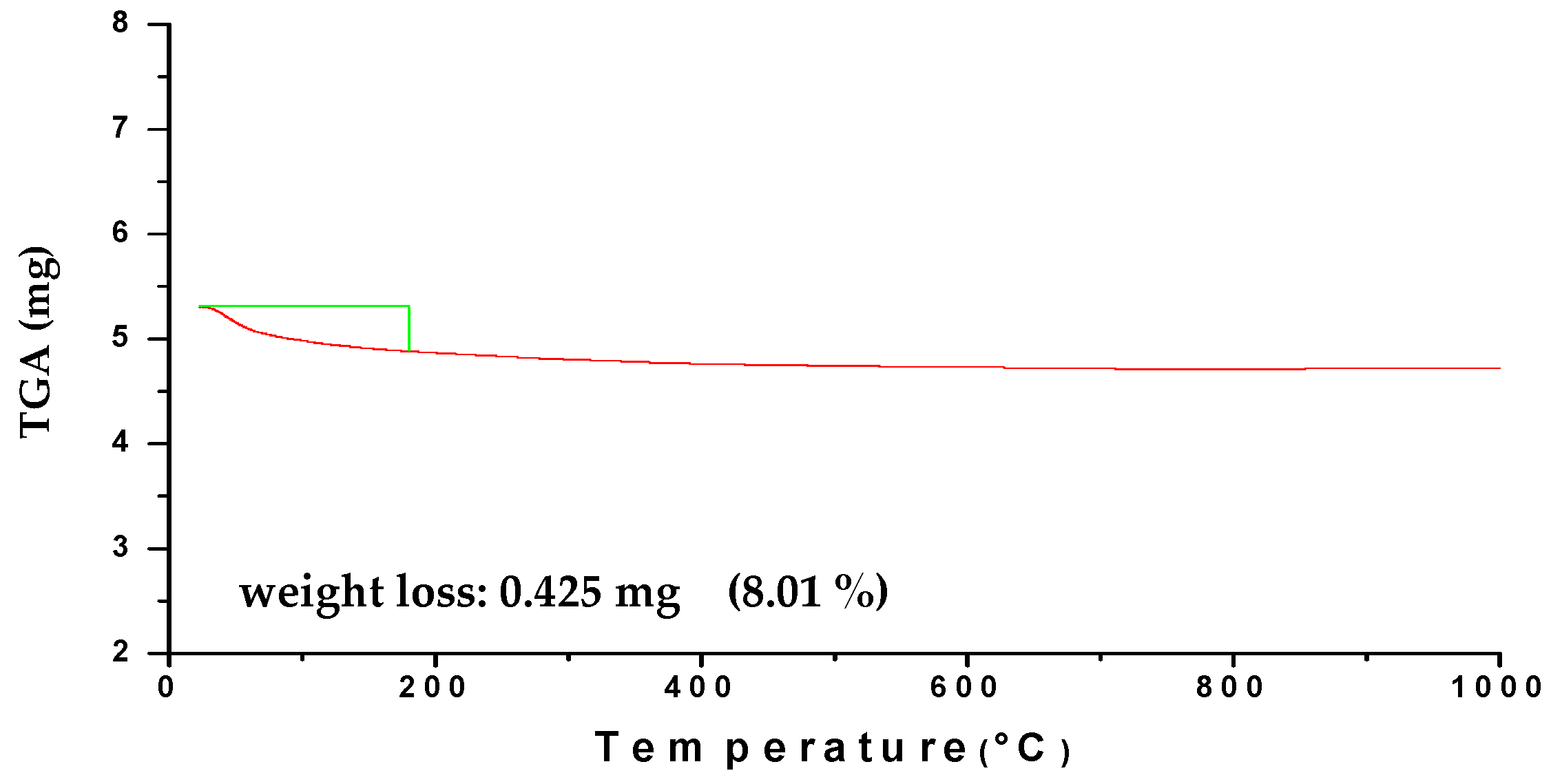
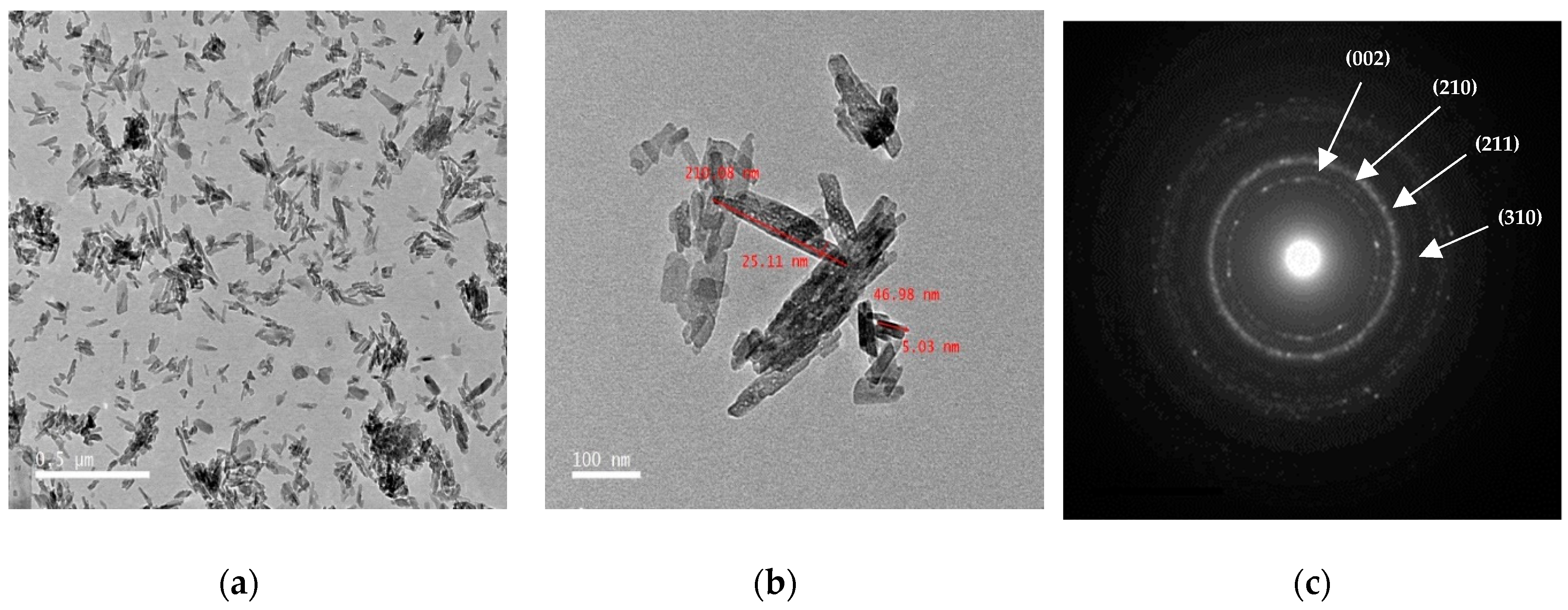
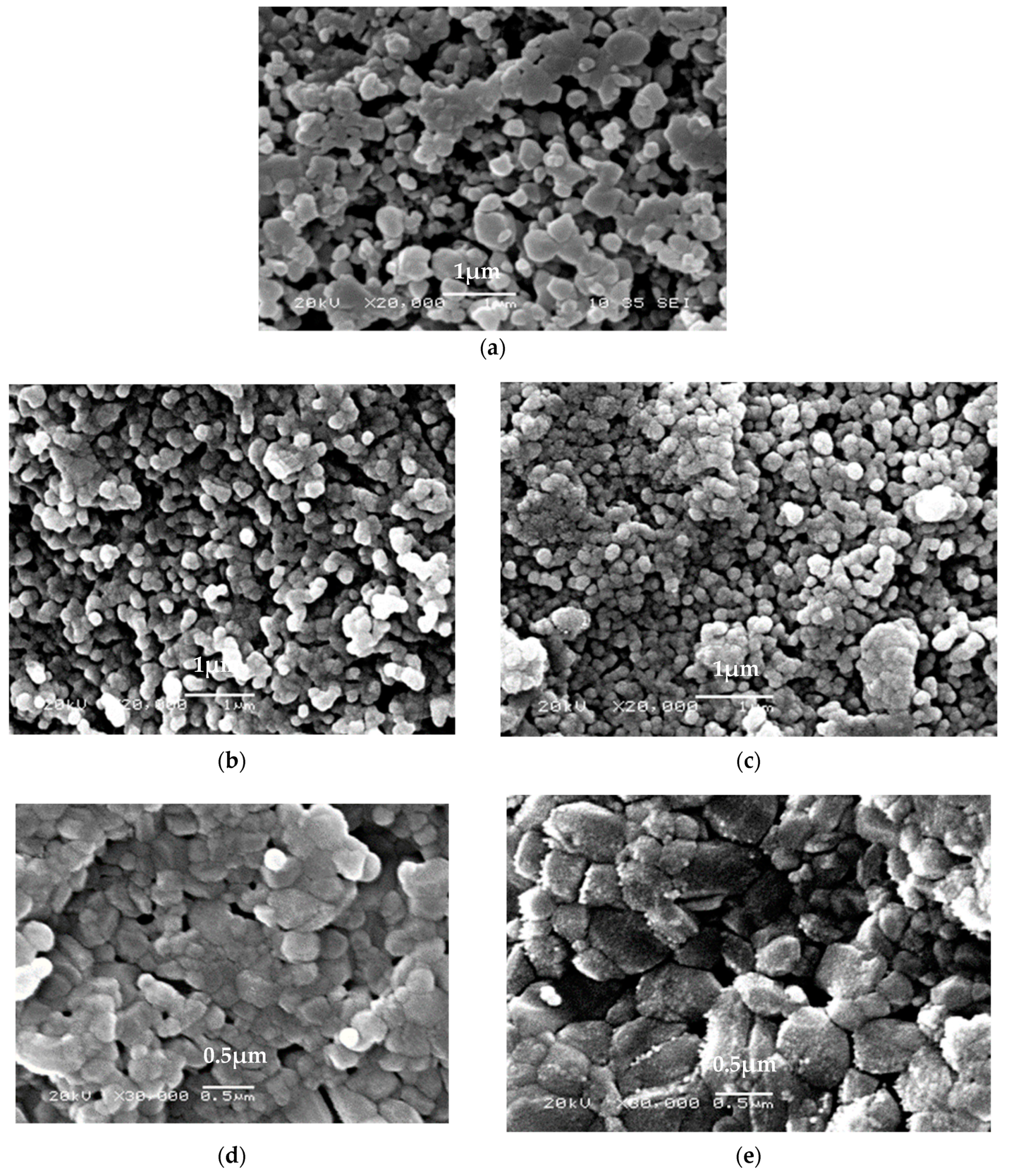
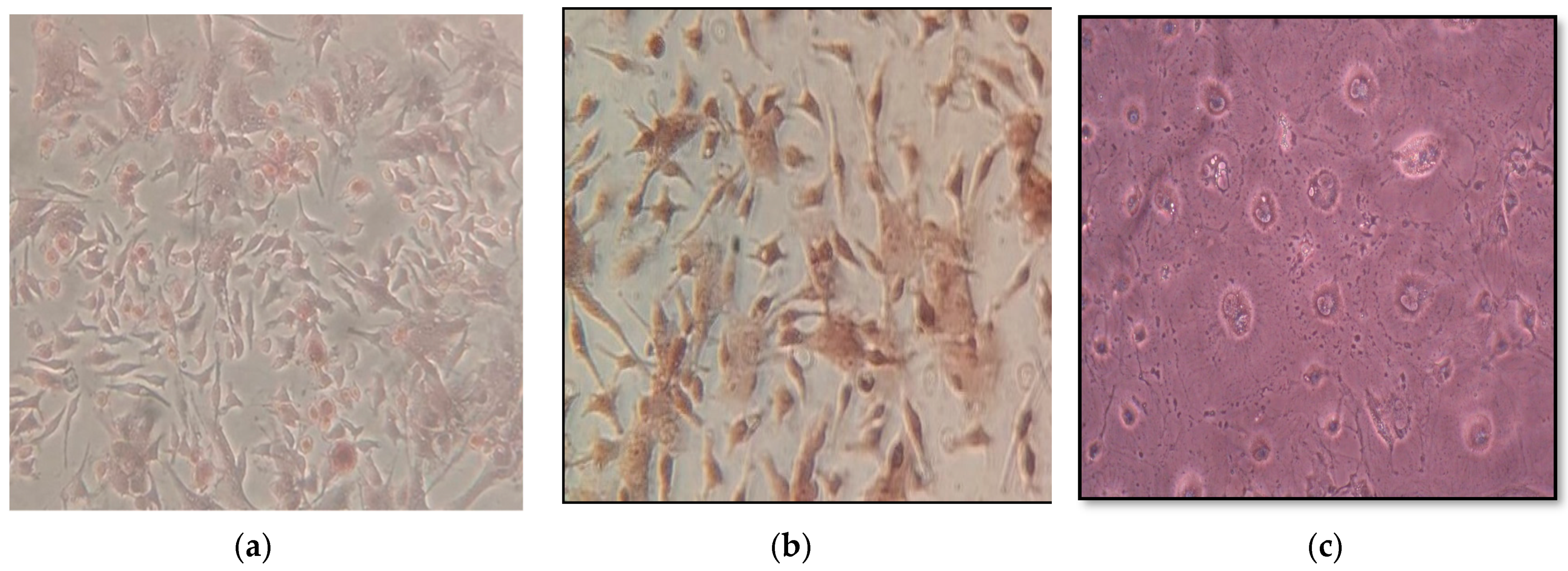
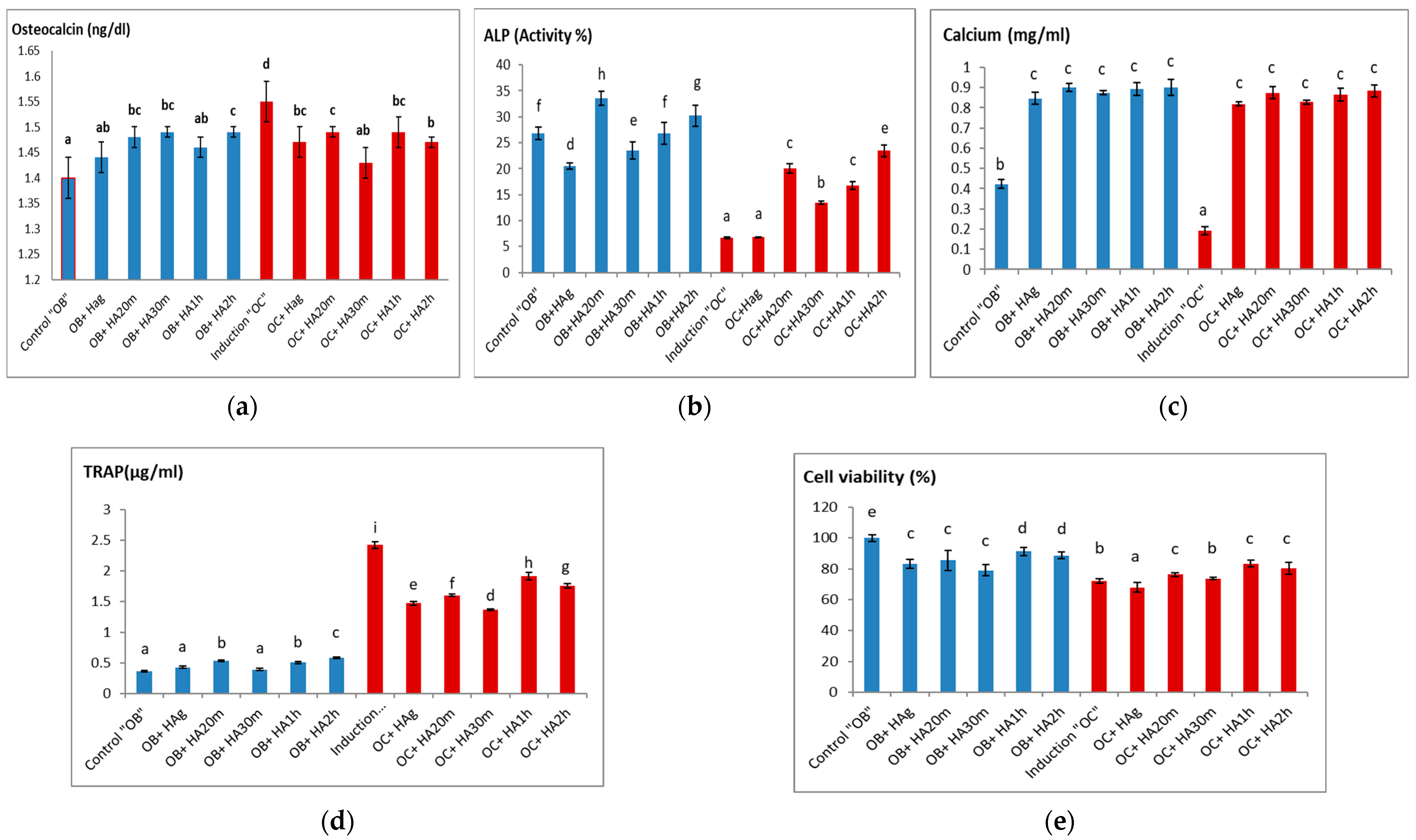
| Sample | Sintering Time | Average Crystallite Size (nm) | Average Crystallinity (%) |
|---|---|---|---|
| HAg | - | 34.9 | 75.09 |
| HA1h | 1 h | 45.7 | 87.31 |
| HA2h | 2 h | 45.6 | 86.69 |
| HA20m | 20 min | 37.9 | 85.87 |
| HA30m | 30 min | 39.1 | 88.72 |
| Sample | Sintering Time | Elements/At (%) | Ca/P Ratio | |||
|---|---|---|---|---|---|---|
| O | Ca | P | C | |||
| HAg | - | 56.92 ± 0.3 | 24.79 ± 0.1 | 14.95 ± 0.5 | 3.34 ± 0.2 | 1.658 |
| HA1h | 1 h | 50.80 ± 0.1 | 23.35 ± 0.1 | 14.02 ± 0.5 | 11.83 ± 0.1 | 1.665 |
| HA2h | 2 h | 50.40 ± 0.5 | 23.82 ± 0.3 | 14.00 ± 0.6 | 11.78 ± 0.2 | 1.701 |
| HA20m | 20 min | 50.90 ± 0.7 | 24.43 ± 0.1 | 14.60 ± 0.3 | 10.07 ± 0.1 | 1.673 |
| HA30m | 30 min | 47.69 ± 0.2 | 23.34 ± 0.2 | 13.91 ± 0.7 | 15.06 ± 0.3 | 1.678 |
| Sample | Sintering Time | Surface Roughness Ra (μm) | Vickers Microhardness | |
|---|---|---|---|---|
| (HV) | (GPa) | |||
| HAg | - | 1.89 ± 0.1 | 16 ± 0.2 | 0.16 ± 0.1 |
| HA1h | 1 h | 0.98 ± 0.1 | 229 ± 2.9 | 2.25 ± 0.2 |
| HA2h | 2 h | 0.87 ± 0.1 | 263 ± 3.8 | 2.58 ± 0.3 |
| HA20m | 20 min | 1.69 ± 0.2 | 104 ± 4.3 | 1.02 ± 0.1 |
| HA30m | 30 min | 1.67 ± 0.1 | 135 ± 5.6 | 1.32 ± 0.1 |
| Groups | CD90 (ng/mg) | CD105 (ng/mg) | PARR- ɣ (pg/mg) | P38-MAPK (ng/mg) | GSK3βpS9 (µg/mg) | GSK3β (µg/mg) | GSK3βpS9 /GSK3β | β.catenin (pg/mg) | |
|---|---|---|---|---|---|---|---|---|---|
| Control OB | 3.21 ± 0.01 A | 1.48 ± 0.07 A | 16.44 ± 1.3 A | 0.35 ± 0.01 A | 3.3 ± 0.02 A | 5.6 ± 0.13 A | 0.59 ± 0.06 B | 1.35 ± 0.005 A | |
| OB | HAg | 3.21 ± 0.02 A | 1.53 ± 0.02 A | 16.93 ± 2.3 A | 0.33 ± 0.02 A | 3.2 ± 0.05 A | 5.3 ± 0.12 A | 0.60 ± 0.07 B | 1.36 ± 0.030 A |
| OB | HA20m | 3.23 ± 0.02 A | 1.46 ± 0.09 A | 17.62 ± 0.9 A | 0.32 ± 0.03 A | 2.8 ± 0.09 A | 5.6 ± 0.21 A | 0.500 ± 0.07 A | 1.37 ± 0.007 A |
| OB | HA30m | 3.19 ± 0.02 A | 1.58 ± 0.05 A | 16.23 ± 1.6 A | 0.34 ± 0.02 A | 3.1 ± 0.01 A | 5.1 ± 0.17 A | 0.61 ± 0.04 B | 1.32 ± 0.003 A |
| OB | HA1h | 3.23 ± 0.01 A | 1.51 ± 0.20 A | 15.31 ± 1.8 A | 0.36 ± 0.01 A | 3.3 ± 0.01 A | 5.5 ± 0.15 A | 0.60 ± 0.08 B | 1.38 ± 0.001 A |
| OB | HA2h | 3.21 ± 0.03 A | 1.45 ± 0.08 A | 16.13 ± 2.8 A | 0.39 ± 0.04 A | 3.4 ± 0.11 A | 5.9 ± 0.23 A | 0.58 ± 0.04 B | 1.36 ± 0.003 A |
| Induction OC | 7.32 ± 0.08 G | 6.85 ± 0.32 F | 54.24 ± 1.6 D | 1.73 ± 0.12 F | 15.7 ± 1.2 E | 11.9 ± 1.80 E | 1.32 ± 0.09 G | 3.97 ± 0.023 F | |
| OC | HAg | 6.20 ± 0.31 F | 5.11 ± 0.24 D | 42.31 ± 2.7 C | 1.63 ± 0.23 E | 11.3 ± 2.3 D | 14.3 ± 1.10 D | 0.790 ± 0.04 F | 3.72 ± 0.120 E |
| OC | HA20m | 3.94 ± 0.07 B | 2.73 ± 0.21 B | 20.36 ± 0.8 B | 0.65 ± 0.03 B | 6.1 ± 0.21 B | 8.92 ± 0.30 B | 0.68 ± 0.01 C | 1.98 ± 0.008 B |
| OC | HA30m | 4.08 ± 0.04 C | 3.01 ± 0.19 B | 18.73 ± 3.1 AB | 0.77 ± 0.02 C | 7.9 ± 0.32 C | 10.9 ± 0.50 C | 0.72 ± 0.02 D | 2.1 ± 0.003 C |
| OC | HA1h | 4.98 ± 0.05 D | 4.17 ± 0.34 C | 18.64 ± 0.9 AB | 0.93 ± 0.07 D | 9.3 ± 0.78 D | 11.9 ± 0.70 C | 0.78 ± 0.03 E | 2.87 ± 0.009 D |
| OC | HA2h | 5.92 ± 0.10 E | 4.93 ± 0.27 D | 40.83 ± 3.7 C | 1.61 ± 0.21 E | 10.8 ± 1.8 D | 13.6 ± 0.90 D | 0.79 ± 0.01 F | 3.63 ± 0.015 E |
Publisher’s Note: MDPI stays neutral with regard to jurisdictional claims in published maps and institutional affiliations. |
© 2021 by the authors. Licensee MDPI, Basel, Switzerland. This article is an open access article distributed under the terms and conditions of the Creative Commons Attribution (CC BY) license (https://creativecommons.org/licenses/by/4.0/).
Share and Cite
Shaban, N.Z.; Kenawy, M.Y.; Taha, N.A.; Abd El-Latif, M.M.; Ghareeb, D.A. Synthesized Nanorods Hydroxyapatite by Microwave-Assisted Technology for In Vitro Osteoporotic Bone Regeneration through Wnt/β-Catenin Pathway. Materials 2021, 14, 5823. https://doi.org/10.3390/ma14195823
Shaban NZ, Kenawy MY, Taha NA, Abd El-Latif MM, Ghareeb DA. Synthesized Nanorods Hydroxyapatite by Microwave-Assisted Technology for In Vitro Osteoporotic Bone Regeneration through Wnt/β-Catenin Pathway. Materials. 2021; 14(19):5823. https://doi.org/10.3390/ma14195823
Chicago/Turabian StyleShaban, Nadia Z., Marwa Y. Kenawy, Nahla A. Taha, Mona M. Abd El-Latif, and Doaa A. Ghareeb. 2021. "Synthesized Nanorods Hydroxyapatite by Microwave-Assisted Technology for In Vitro Osteoporotic Bone Regeneration through Wnt/β-Catenin Pathway" Materials 14, no. 19: 5823. https://doi.org/10.3390/ma14195823
APA StyleShaban, N. Z., Kenawy, M. Y., Taha, N. A., Abd El-Latif, M. M., & Ghareeb, D. A. (2021). Synthesized Nanorods Hydroxyapatite by Microwave-Assisted Technology for In Vitro Osteoporotic Bone Regeneration through Wnt/β-Catenin Pathway. Materials, 14(19), 5823. https://doi.org/10.3390/ma14195823








